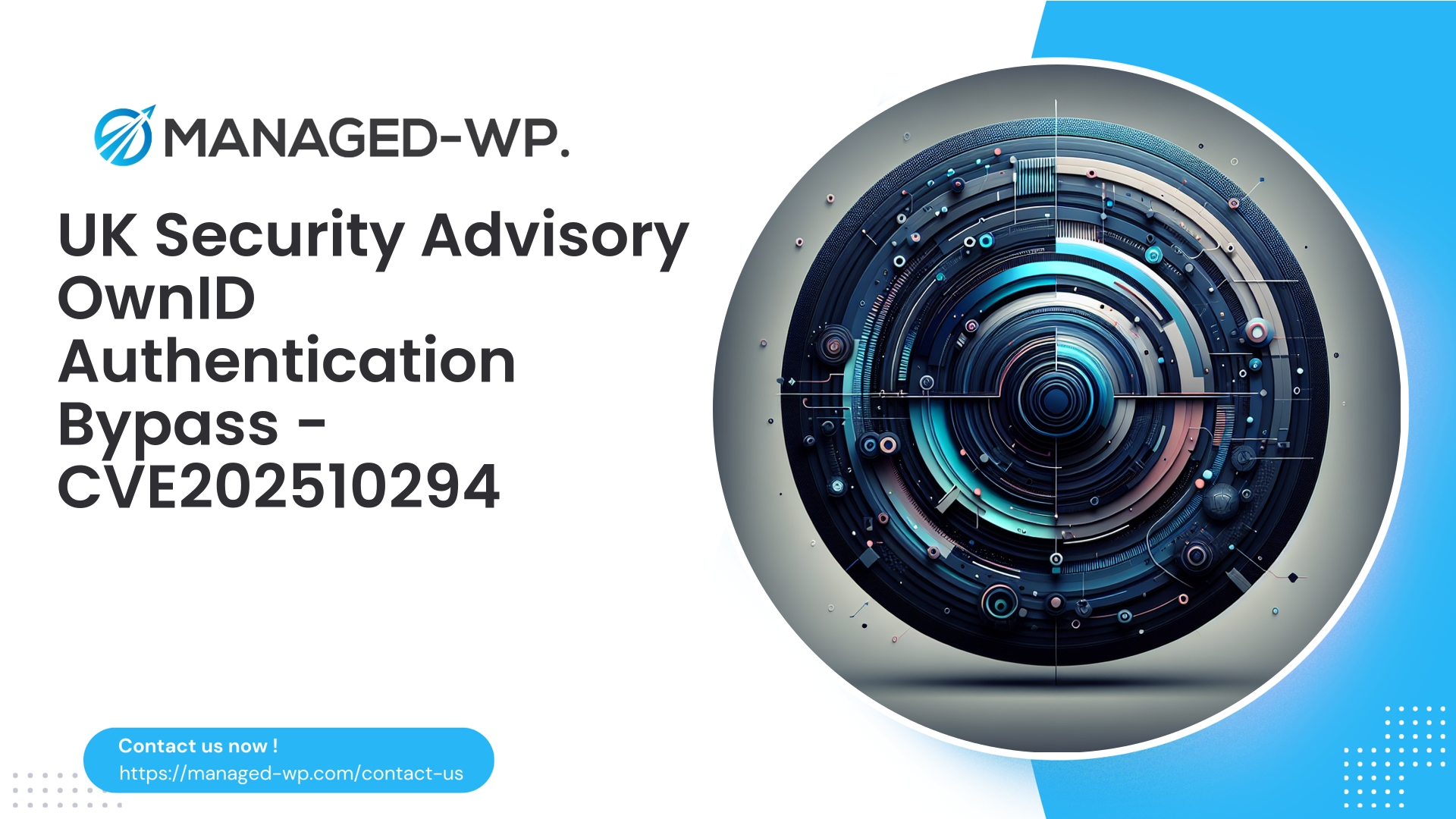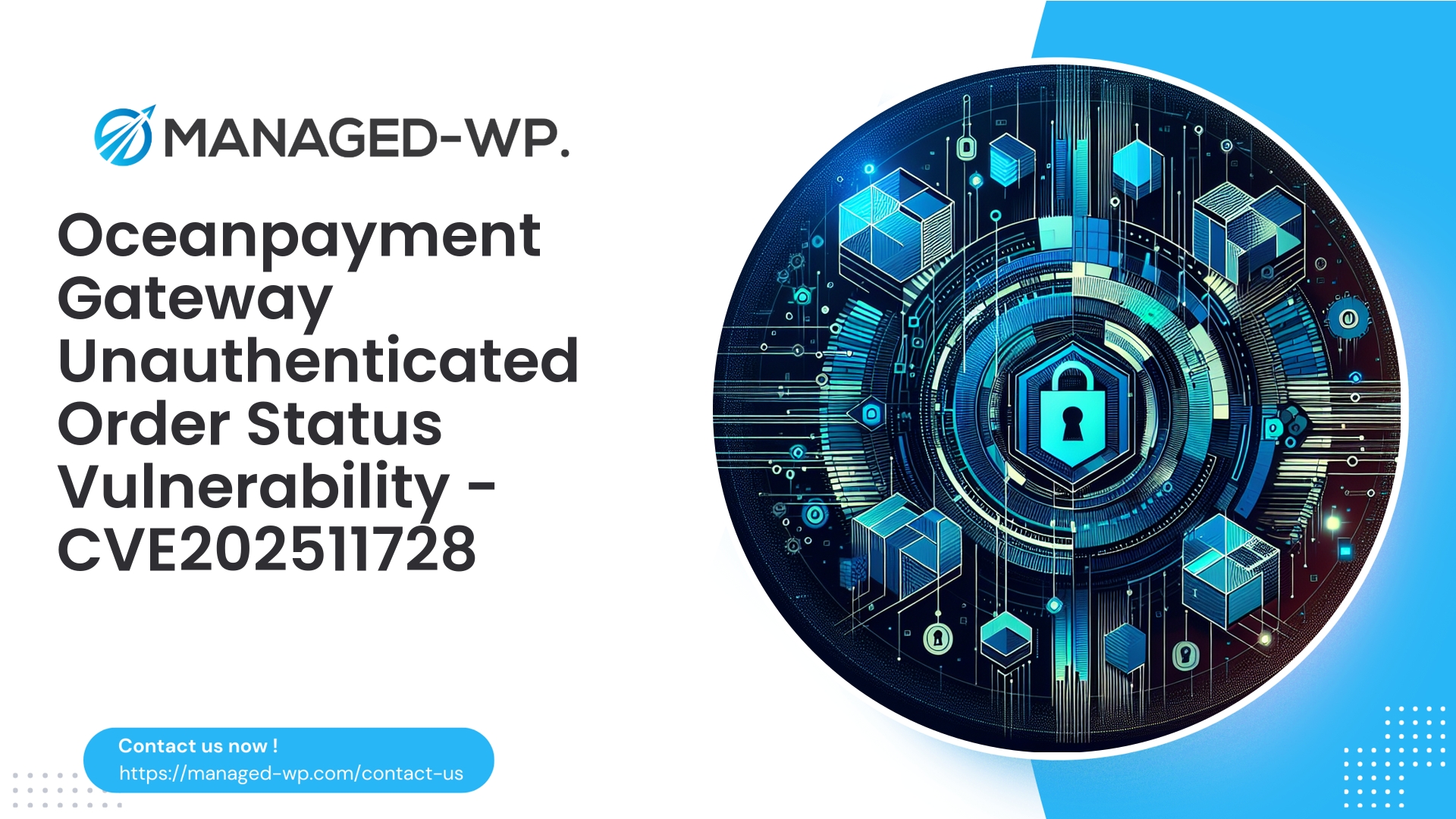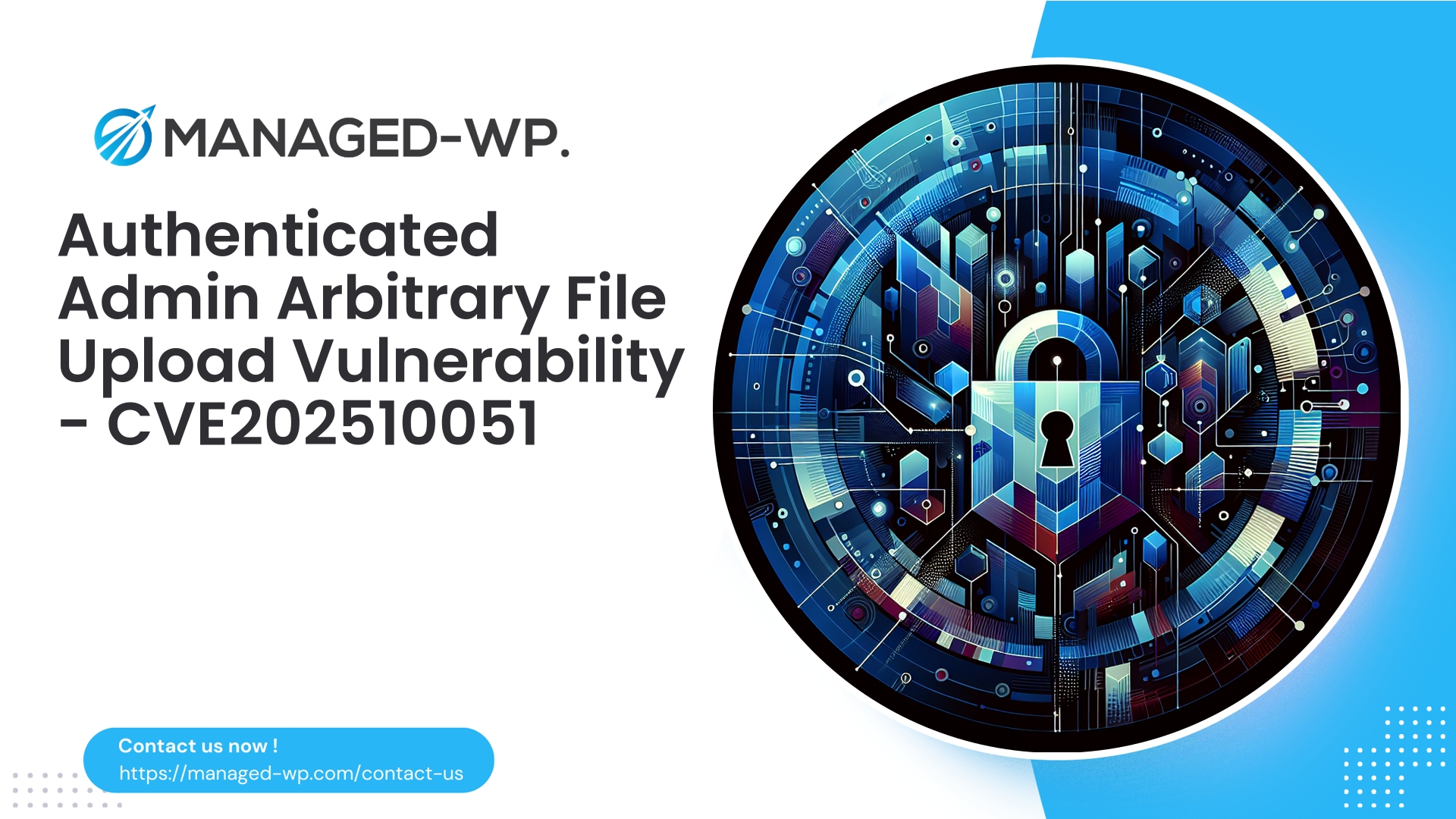| 插件名称 | OwnID Passwordless Login |
|---|---|
| Type of Vulnerability | Authentication Bypass |
| CVE Number | CVE-2025-10294 |
| Urgency | High |
| CVE Publish Date | 2025-10-15 |
| Source URL | CVE-2025-10294 |
Critical Authentication Bypass in OwnID Passwordless Login (≤ 1.3.4) — Immediate Actions for WordPress Site Owners
作者: Managed-WP Security Experts
Date: 2025-10-15
标签: WordPress, security, vulnerability, authentication bypass, incident response
Executive Summary — A severe vulnerability identified as CVE-2025-10294 affects the OwnID Passwordless Login WordPress plugin (versions ≤ 1.3.4). This flaw permits unauthenticated actors to bypass authentication controls, enabling potential unauthorized access to WordPress sites. Classified as a high-severity “Broken Authentication” risk, immediate remediation is critical for all sites employing this plugin or any associated passwordless authentication mechanisms.
Why This Vulnerability Demands Immediate Attention
Passwordless authentication mechanisms are designed to enhance user experience by reducing reliance on traditional passwords. However, such convenience introduces concentrated trust across critical validation points such as callback endpoints, token verification, session handling, and nonce/state management. If these security checks are flawed or circumventable, malicious actors can gain the same privileges as legitimate users — including full administrator access. OwnID Passwordless Login versions up to 1.3.4 are precisely vulnerable to such exploitation.
This analysis lays out the nature of the threat, detection strategies, and clear, expert-recommended steps to safeguard and recover your WordPress environment.
Urgent Steps to Take Right Now
- Disable OwnID Passwordless Login Plugin Immediately:
- Deactivate the plugin without delay until a verified security patch is available.
- WP-CLI command:
wp plugin deactivate ownid-passwordless-login - Or via WordPress Admin Dashboard: Plugins → Installed Plugins → Deactivate
- WP-CLI command:
- Deactivate the plugin without delay until a verified security patch is available.
- If immediate deactivation is not feasible, enforce strict access controls on
wp-adminby limiting to trusted IPs and applying rigorous rate limiting via your webserver or firewall. - Continuously monitor authentication and user management logs for unusual activities (see detection section).
- Implement virtual patching at the WAF layer to block suspicious plugin endpoints and parameter patterns aligned with the vulnerable passwordless authentication workflow.
- Rotate all relevant authentication secrets and credentials, force password resets, and invalidate active sessions for administrative accounts.
- If signs of compromise emerge, initiate the incident response and cleanup protocols immediately.
Do not delay these actions; taking them now is essential to preventing exploitation.
Vulnerability Details
- Plugin: OwnID Passwordless Login
- Affected Versions: 1.3.4 and earlier
- Vulnerability Type: Broken Authentication (OWASP A7)
- CVE Identifier: CVE-2025-10294
- Reported By: Jonas Benjamin Friedli
- Access Required: None (Unauthenticated)
- Patch Availability: None at disclosure time
This vulnerability stems from insufficient validation within the plugin’s passwordless login implementation, allowing attackers to bypass login mechanisms and gain unauthorized sessions remotely without credentials.
Technical Insight
Passwordless authentication generally involves:
- User triggers a passwordless login request.
- The system generates a temporary token and sends a verification prompt out-of-band (email, SMS, app).
- The login callback validates this token and establishes a user session upon success.
Robust implementations ensure tokens are signed, time-limited, bound to specific users and nonces, and validate request origins rigorously.
This vulnerability indicates one or more critical validation steps—such as token verification, nonce enforcement, or origin checks—are either missing or improperly executed, allowing attackers to forge authenticated sessions arbitrarily.
重要的: Sharing exploit proof-of-concept publicly risks facilitating attacks. Focus efforts exclusively on mitigation and detection.
Potential Impact of Exploitation
- Full Site Takeover: Unauthorized admin access, content modification, plugin/theme tampering.
- Data Exposure: Unauthorized access to sensitive and private user data.
- Persistent Threats: Creation of covert admin accounts, backdoors, or scheduled tasks.
- Reputational and Operational Damage: Defacement, spam injection, blacklisting by search engines.
- Security Risks to Hosting Environment: On shared platforms, compromised sites can facilitate lateral movement to other accounts.
The unauthenticated nature makes this vulnerability a prime target for automated scanning and mass exploitation campaigns.
How to Detect Signs of Exploitation
- Look for Unexpected Administrative Users:
- WP-CLI:
wp user list --role=administrator - Dashboard: Users → All Users (filter by Administrator role)
- Check for recently added accounts or suspicious emails.
- WP-CLI:
- Verify Login Activity Patterns:
- Analyze server logs for unusual POST requests to
wp-login.phpor relevant REST endpoints. - Check audit logs for admin logins from unfamiliar IPs or at odd times.
- Analyze server logs for unusual POST requests to
- Scan for Unauthorized File Modifications:
- Look for new or recently changed files in plugin, theme, and
wp-内容directories. - Search for suspicious PHP code using keywords such as
eval,base64_decode, 或者gzuncompress. - Example command:
find . -type f -mtime -14 -print
- Look for new or recently changed files in plugin, theme, and
- Monitor Database Integrity:
- Inspect
wp_optionsfor abnormal autoloaded values or unauthorized cron jobs. - Query for suspicious option entries with:
SELECT option_name, LENGTH(option_value) FROM wp_options WHERE option_name LIKE '%template%' OR option_name LIKE '%cron%';
- Inspect
- Check for Anomalous Outgoing Traffic:
- Review firewall/network logs for connections to unfamiliar IP addresses initiated by your server.
- Analyze Passwordless Endpoint Traffic:
- Review HTTP logs for suspicious requests or abnormal parameter patterns related to the plugin’s authentication endpoints.
Retain detailed logs securely for in-depth forensic review if required.
Immediate Mitigation Strategies for Site Owners and Administrators
- Deactivate the Vulnerable Plugin Immediately:
- This is the most effective preventive action.
- Bulk command example:
wp plugin deactivate ownid-passwordless-login --allow-root
- When Immediate Deactivation Is Impossible:
- Restrict plugin endpoint access by IP via webserver configurations (.htaccess, nginx).
- Example nginx block snippet:
location ~* /wp-content/plugins/ownid-passwordless-login/ {
return 403;
}
- 笔记: Blocking plugin paths may disrupt functionality—deactivation remains preferable.
- Deploy WAF Virtual Patching:
- Block known suspicious parameters and session-creating endpoints.
- Enforce header validation – Origin, Referer, and Content-Type.
- Apply strict IP rate limiting to frustrate automated exploits.
- Credential and Session Hygiene:
- Force password resets for all administrative users.
- Invalidate active sessions using WordPress plugins or by forcing user logout.
- Rotate shared API keys and authentication secrets.
- Enhance Admin Access Controls:
- Restrict wp-admin access to known IP addresses.
- Enable multi-factor authentication on admin accounts.
- Consider moving login pages or implementing HTTP Basic Authentication for wp-admin.
- Maintain Reliable Backups:
- Ensure readily accessible clean backups created before any suspected compromise.
Managed-WP Virtual Patch Recommendations for WAFs
As a trusted WordPress security service provider, Managed-WP strongly recommends layering WAF protections to reduce your exposure until a plugin patch is released:
- Block or challenge requests targeting vulnerable plugin endpoints:
- Identify relevant REST, AJAX, and PHP files associated with the plugin.
- Enforce CAPTCHAs or JavaScript challenges for POST requests from untrusted sources.
- Strict enforcement of HTTP header validation:
- Permit requests that create sessions only with valid Origin and Referer headers.
- Reject requests with missing, malformed, or obviously forged headers.
- Rate-limiting and throttling:
- Apply aggressive rate limits per IP on sensitive endpoints.
- Use progressive delays or temporary blocking on repeated failed attempts.
- Anomaly detection on parameters:
- Create rules identifying malformed or suspicious tokens or state parameters.
- Access-layer protections for admin interfaces:
- Add IP whitelisting or additional authentication for wp-admin and XML-RPC endpoints.
- Audit logging and alerting:
- Generate alerts on session creation without valid states or challenges.
- Ensure alerts notify site administrators or hosting teams promptly.
笔记: WAF rules provide temporary mitigation — updating or replacing the vulnerable plugin with a secure solution remains imperative.
Logging and Detection Signature Recommendations
Implement detection rules and logging for the following indicators:
- POST requests targeting plugin-specific endpoints without active session cookies.
- Successful session creation responses (200/302) immediately followed by requests accessing administrative URLs from the same IP.
- Repeated attempts to create or modify user accounts using the vulnerable endpoints.
- High volume or burst traffic patterns targeting passwordless login endpoints.
Critical log fields for comprehensive correlation include:
- Timestamp, source IP Address, User-Agent header
- Full Request URI and query string
- Parameter names within POST bodies (avoid logging sensitive token values)
- HTTP Response codes and sizes
- Session cookie presence and session identifiers
Store logs securely off-host to protect against tampering in case of compromise.
Incident Response and Cleanup Protocol
- Isolate the Site:
- Enable maintenance mode or temporarily take the site offline.
- If hosted on shared infrastructure, alert your hosting provider immediately for isolation measures.
- Preserve Evidence:
- Collect and securely preserve copies of server logs, database dumps, and file system snapshots for forensics.
- Do not alter these copies to maintain integrity.
- Rotate Credentials:
- Reset WordPress admin passwords, API keys, and hosting credentials.
- Remove and Replace the Vulnerable Plugin:
- Deactivate and delete OwnID Passwordless Login.
- Use thoroughly reviewed alternatives only after comprehensive testing.
- Remove Backdoors and Malicious Code:
- Search for PHP code containing suspicious functions such as
eval,base64_decode,preg_replace(with /e),create_function,gzinflate,system,exec, 和shell_exec. - Example command:
grep -R --exclude-dir=uploads -nE "eval\(|base64_decode\(|gzinflate\(|shell_exec\(|system\(" .
- Search for PHP code containing suspicious functions such as
- Database Integrity Check:
- Verify
wp_usersfor unrecognized accounts. - Inspect
wp_optionsfor injected autoloaded code. - Check
wp_postsfor suspicious script injections.
- Verify
- Reinstall Core, Themes, and Plugins:
- Do not rely on potentially tainted existing files; obtain fresh copies from official sources.
- Restore from Clean Backup:
- If available, restore backups taken prior to compromise, then reinforce security controls.
- Post-Recovery Monitoring:
- Monitor site activity rigorously for at least 30 days.
- Consider engaging professional security audits for sensitive sites.
- Engage Professional Incident Response Services:
- Highly recommended if handling significant financial or personal data.
Long-Term WordPress Authentication Hardening
- Eliminate single points of failure by implementing cryptographically signed tokens, nonce binding, and strict validation in passwordless flows.
- Adopt multi-factor authentication across all administrative accounts.
- Apply the least privilege principle by minimizing the number of admin users.
- Keep all plugins and themes updated and source only from reputable providers.
- Centralize monitoring and patch management for enhanced oversight.
- Enable and review detailed logging and alerting mechanisms for critical events.
- Harden file system permissions; disable PHP execution in upload directories where feasible:
<FilesMatch "\.php$"> Deny from all </FilesMatch> - Enforce robust password policies with periodic rotation for admin users.
Guidance for Plugin Developers: Secure-by-Design Principles
- Utilize signed tokens (e.g., JWT) incorporating short expiry and strict audience validation.
- Bind tokens to server-stored state or nonce parameters to prevent replay attacks.
- Strictly validate redirect URIs and origins to prevent injection or forgery.
- Verify token issuer and signature rigorously.
- Avoid session creation or privilege elevation on simple GET requests.
- Implement CSRF and nonce protections on all state-changing endpoints.
- Log critical authentication events without exposing secrets.
- Maintain a transparent responsible disclosure and patch management process.
- Provide clear security hardening recommendations and WAF rule suggestions to site owners.
Operational Recommendations for Hosts and Agencies
- Deploy rapid patching and virtual patching capabilities for plugins with widespread use.
- Offer site isolation and security scans to affected customers proactively.
- Implement edge blocking and rate limiting for known exploit patterns.
- Communicate promptly with clients, offering actionable remediation steps and support.
- Maintain tested backup and recovery processes, supplemented with incident response services.
Timeline & References
- Reported on: October 15, 2025
- CVE Identifier: CVE-2025-10294
- Research credited to: Jonas Benjamin Friedli
For detailed technical disclosure, refer to the official CVE entry and the researcher’s analysis. Exploit code is omitted here to prevent aiding malicious actors.
常见问题
Q: Will deactivating the plugin prevent users from accessing their accounts?
A: Yes, deactivating OwnID Passwordless Login disables the passwordless authentication method. Users will need to log in with traditional credentials or alternative authentication methods until a secure fix or replacement is implemented.
Q: Does having the plugin installed mean my site is compromised?
A: Not necessarily. Installing the plugin only means your site is vulnerable. Whether it has been compromised depends on whether someone exploited the vulnerability. You must assume risk and take immediate action.
Q: When will an official patch be available?
A: At disclosure, no patch is available. Monitor official plugin channels and apply updates promptly once released. Until then, follow the recommended mitigations strictly.
Enhance Your WordPress Security with Managed-WP Basic (Free) Plan
Essential Managed Security at No Cost
Managed-WP offers a Basic (Free) security plan tailored for WordPress site owners seeking effective protection without financial commitment. Our free tier includes managed firewall services, unlimited bandwidth, an active Web Application Firewall (WAF), malware scanning, and comprehensive defenses against OWASP Top Ten risks. This plan helps minimize your exposure to vulnerabilities like the one detailed here.
Enroll today for immediate deployment of virtual patching rules to your site: https://my.wp-firewall.com/buy/wp-firewall-free-plan/
For enhanced features such as automated malware removal, IP management, monthly security reports, and advanced virtual patching, explore our Standard and Pro plans.
Final Recommendations — Act Now to Protect Your Site
This authentication bypass vulnerability represents an acute security threat because it requires no authentication to exploit. If your WordPress environment uses OwnID Passwordless Login up to version 1.3.4, immediately deactivate or block the plugin, enable WAF mitigations, and scrutinize logs for suspicious activity.
For organizations managing multiple WordPress sites, leveraging a managed firewall and security service like Managed-WP provides automated detection and mitigation, significantly reducing manual response burdens while protecting your customer base.
If you require assistance assessing your site or implementing virtual patches, Managed-WP Security Experts are ready to support your rapid remediation and recovery efforts.
Stay secure,
The Managed-WP Security Experts



















